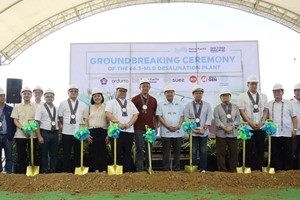Brackish water desalination, a crucial process for ensuring access to clean water, has seen significant advancements through the development of composite electrodes using metal-organic frameworks (MOFs). Capacitive deionization (CDI) technology, a promising method for desalination, has been notably enhanced by incorporating zinc-benzene tricarboxylic acid (Zn-BTC) MOFs into electrodes. This innovation has led to remarkable improvements in electrochemical performance and desalination efficiency.
Composite Electrodes for CDI
Composite electrodes containing activated carbon (AC), polyvinylidene fluoride (PVDF), and Zn-BTC MOF have demonstrated significant improvements in CDI performance. Among the various compositions tested, the E4 electrode, containing 6% Zn-BTC MOF, exhibited the best performance in cyclic voltammetry (CV) and electrochemical impedance spectroscopy (EIS) analyses. With a specific capacity of 88 F g−1 and a low ion charge transfer resistance of 4.9 Ω, the E4 electrode outperformed its counterparts. Specifically, it showed a 46.7% increase in specific capacitance compared to the E1 electrode, which did not include the MOF.
Physicochemical and Electrochemical Characterization
Comprehensive physicochemical analyses, including X-ray diffraction (XRD), Fourier transform infrared spectroscopy (FTIR), field emission scanning electron microscopy (FESEM), Brunauer-Emmett-Teller (BET) analysis, energy dispersive spectroscopy (EDS), elemental mapping, and contact angle measurements, confirmed the superior properties of the E4 electrode. These analyses verified successful MOF synthesis, desirable pore size, and enhanced hydrophilicity, all contributing to the improved performance of the E4 electrode.
The XRD analysis confirmed the successful construction of the Zn-BTC MOF, while the FTIR analysis provided insights into the chemical structure and bonding. FESEM images revealed the morphology of the Zn-BTC MOF particles, which exhibited both spherical and polyhedral shapes with varying sizes. The BET analysis showed a specific surface area of 34 m² g−1 and a mean pore diameter of 11.54 nm, indicating a mesoporous structure advantageous for ion adsorption and electrical double-layer formation.
Desalination Performance
Evaluating the salt removal capacity (SRC) in various setups using a 100.0 mg L−1 NaCl feed solution demonstrated that the asymmetric arrangement of E1 and E4 electrodes outperformed symmetric arrangements. This configuration achieved a 21.1% increase in SRC, reaching 6.3 mg g−1. The enhanced performance can be attributed to the high porosity, specific surface area, suitable wettability, and electrochemical properties of the E4 electrode.
The specific capacitance and overall electrochemical resistance of the electrodes were measured using CV and EIS tests. The E4 electrode, with 6% Zn-BTC MOF, demonstrated the highest specific capacitance and lowest ion charge transfer resistance. This improvement is likely due to the high hydrophilicity and proper pore size distribution provided by the Zn-BTC MOF.
Synthesis and Fabrication of Composite Electrodes
The Zn-BTC MOF was synthesized using a solvothermal method. Zinc nitrate hexahydrate and benzene-1,3,5-tricarboxylic acid were dissolved in ethanol and stirred before being transferred to a Teflon-lined stainless-steel autoclave for reaction. The resulting Zn-BTC MOF crystals were then centrifuged, washed, and dried.
Composite electrodes were fabricated by preparing electrode ink from AC, PVDF, and Zn-BTC MOF in varying proportions. The ink was then coated onto carbon cloth and dried in a vacuum oven. The E4 electrode, selected for its superior performance in preliminary tests, underwent further characterization and desalination tests.
Future Implications and Conclusion
The integration of Zn-BTC MOF into composite electrodes for CDI has proven to be a significant advancement in desalination technology. The improved specific capacitance, low ion charge transfer resistance, and enhanced hydrophilicity of the E4 electrode highlight the potential of MOF-based materials in electrochemical applications.
The study demonstrates that even a small percentage of Zn-BTC MOF can significantly enhance electrode performance, paving the way for more efficient and cost-effective desalination processes. Future research should focus on optimizing MOF content and exploring other MOF structures to further improve CDI technology.
by Amirshahriar Ghorbanian, Soosan Rowshanzamir, and Foad Mehri













